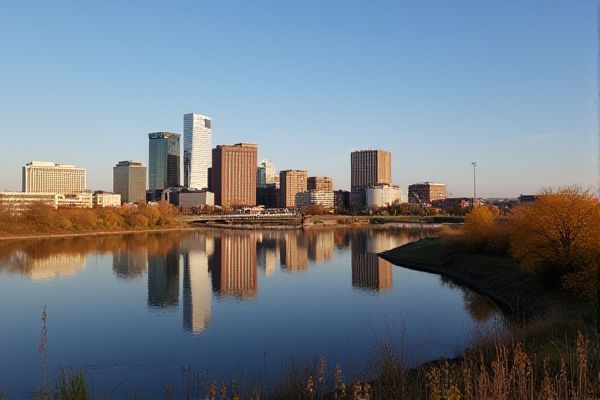
Internet and telecommunications options in Minnesota: Broadband availability varies by region. Fiber-optic services common in urban areas. Several major ISPs operate statewide. Rural areas often use satellite internet. 5G network expanding in metro areas. Public Wi-Fi hotspots in many cities. State broadband grants support expansion. Internet speed may vary by provider. Cable and DSL widely available options. Mobile phone coverage varies by carrier.
Broadband availability varies by region.
Broadband availability in Minnesota varies significantly by region, with some areas like Inver Grove Heights and Minnetonka having nearly 100% access to high-speed internet, while others such as Long Prairie and Rush City have much lower coverage rates, ranging from 69.8% to 65.5%. For more detailed information on broadband coverage across the state, visit the Minnesota Broadband Coverage page, which provides insights into how connectivity differs from one area to another.
Fiber-optic services common in urban areas.
Fiber-optic services are common in urban areas of Minnesota, with providers such as Quantum Fiber, Frontier Fiber, Metronet, and Midco offering fast, symmetrical speeds and extensive coverage, particularly in cities like Minneapolis and St. Paul. These providers ensure that residents have access to reliable and high-speed internet, making them some of the Best Internet Providers In Minnesota. The expansion of these networks supports the needs of growing communities and boosts overall connectivity.
Several major ISPs operate statewide.
Several major ISPs operate statewide in Minnesota, including Quantum Fiber, US Internet, Xfinity, CenturyLink, and Metronet, offering a range of internet services from fiber and cable to DSL, with varying speeds and coverage areas across the state. For more detailed information on the best internet providers in Minnesota, consider exploring different company offerings to find the most suitable plan for your needs.
Rural areas often use satellite internet.
In rural Minnesota, satellite internet providers such as Viasat are often the best option, offering high-speed internet with download speeds up to 100-150 Mbps. However, it's important to note that these speeds may slow down after reaching data thresholds and during peak times. For more detailed information on internet options, including availability and pricing, be sure to visit the Rural Internet Service resource.
5G network expanding in metro areas.
Verizon is expanding its 5G network in Minneapolis, deploying new cell sites to extend coverage and capacity, utilizing mmWave and C-band spectrum to deliver high-speed 5G Ultra Wideband service, and upgrading fiber optic cable links to increase data capacity. This enhancement includes additional coverage in areas such as Downtown Minneapolis, Lino Lakes, and several other local communities. For more details on this network upgrade, visit the Verizon News section on their website.
Public Wi-Fi hotspots in many cities.
Minnesota, particularly Minneapolis, offers a plethora of public Wi-Fi hotspots, with over 544 free Wi-Fi locations identified, including popular spots like the Minneapolis Institute of Art, the Walker Art Center, and the Mall of America.
State broadband grants support expansion.
The Border-to-Border Broadband Development Grant Program in Minnesota diligently funds the expansion of broadband service to unserved or underserved areas. This initiative has allocated a substantial $50 million for fiscal years 2024 and 2025, along with additional funding from federal sources such as the Broadband Equity, Access, and Deployment Program. These grants are pivotal in supporting projects that offer high-speed broadband with minimum speeds of 100 Mbps download and 20 Mbps upload. The primary goal of the Grant Program is to connect thousands of homes and businesses across the state, significantly enhancing digital accessibility and economic growth in these communities.
Internet speed may vary by provider.
In Minneapolis, Minnesota, internet speeds vary significantly by provider, with the fastest options including Quantum Fiber offering up to 8 Gbps, Xfinity up to 2 Gbps, and Verizon 5G Home Internet up to 1 Gbps. Meanwhile, other providers such as AT&T, T-Mobile, and satellite services offer lower speeds ranging from 100 Mbps to 245 Mbps. For more detailed information on internet providers in Minneapolis, you can visit the In My Area website, where you can compare the offerings and select the best fit for your needs.
Cable and DSL widely available options.
In Minnesota, Cable Internet is widely available and generally faster, with speeds up to 1,200 Mbps. Meanwhile, DSL internet, though more widely accessible in remote areas, offers slower speeds up to 100 Mbps. It is often cheaper yet less suitable for heavy internet use. For more detailed information, explore the differences by visiting the HighSpeedInternet website, where you can compare the benefits and limitations of each option.
Mobile phone coverage varies by carrier.
In Minnesota, mobile phone coverage varies significantly by carrier, with AT&T and Verizon offering extensive and reliable 4G LTE and expanding 5G networks, especially in urban and rural areas. Meanwhile, T-Mobile leads in 5G coverage with the fastest speeds. US Mobile stands out for its flexible and affordable coverage with minimal dead zones.
